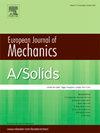Free vibration and stochastic dynamic response of functionally graded graphene platelet-reinforced composite cabin assemblages
IF 4.2
2区 工程技术
Q1 MECHANICS
引用次数: 0
Abstract
The pursuit of higher performance and lighter weight in aircraft design poses critical challenges to cabin structures, particularly from stationary and non-stationary stochastic excitations during service, which threaten vibration resistance. However, existing studies are predominantly limited to the deterministic or stationary vibration of single composite shells. A significant gap exists in the development of unified dynamic models for functionally graded graphene platelet-reinforced composite (FG-GPLRC) cabin assemblages, particularly for analyzing their non-stationary responses. This gap hinders reliable engineering design. This study conducts dynamic modeling and characteristic analysis of FG-GPLRC cabin assemblages. In this study, the material properties of each layer were first determined using the Halpin-Tsai model and the rule of mixtures. Subsequently, a unified dynamic model for the combined shell structures was developed based on the first-order shear deformation theory (FSDT), the spectro-geometric method (SGM), and the pseudo-excitation method (PEM). The interactions between adjacent shells were simulated with elastic couplers, whose potential energy was formulated based on displacement continuity and force balance conditions. The final model, established by incorporating the work done by external loads and the energy of boundary constraint springs, was validated through convergence studies and comparisons with finite element method (FEM) results. The free vibration and stationary/nonstationary stochastic dynamic characteristics of the assemblages were thoroughly investigated. The results elucidate the dynamic behaviour of FG-GPLRC cabin assemblages and provide a theoretical foundation for the vibration-resistant design of aircraft cabins.
功能梯度石墨烯平板增强复合材料舱室组件的自由振动和随机动力响应
在飞机设计中,追求更高的性能和更轻的重量对客舱结构提出了严峻的挑战,特别是在使用过程中来自静止和非静止随机激励的挑战,这些随机激励会威胁到飞机的抗振动能力。然而,现有的研究主要局限于单个复合材料壳体的确定性或稳态振动。在功能梯度石墨烯平板增强复合材料(FG-GPLRC)舱室组件的统一动态模型的开发方面存在重大差距,特别是在分析其非平稳响应方面。这种差距阻碍了可靠的工程设计。本研究对FG-GPLRC客舱组合进行了动力学建模和特性分析。在本研究中,首先使用Halpin-Tsai模型和混合规则确定了每层的材料性能。随后,基于一阶剪切变形理论(FSDT)、谱几何法(SGM)和伪激励法(PEM)建立了组合壳结构的统一动力模型。采用弹性偶合器模拟相邻壳体间的相互作用,并根据位移连续性和力平衡条件建立偶合器势能公式。通过收敛性研究以及与有限元法(FEM)结果的比较,验证了将外部载荷所做功与边界约束弹簧能量相结合建立的最终模型的正确性。深入研究了组合体的自由振动和静/非静随机动力特性。研究结果阐明了FG-GPLRC座舱组合的动力特性,为飞机座舱的抗振设计提供了理论依据。
本文章由计算机程序翻译,如有差异,请以英文原文为准。
求助全文
约1分钟内获得全文
求助全文
来源期刊
CiteScore
7.00
自引率
7.30%
发文量
275
审稿时长
48 days
期刊介绍:
The European Journal of Mechanics endash; A/Solids continues to publish articles in English in all areas of Solid Mechanics from the physical and mathematical basis to materials engineering, technological applications and methods of modern computational mechanics, both pure and applied research.

 求助内容:
求助内容: 应助结果提醒方式:
应助结果提醒方式:


